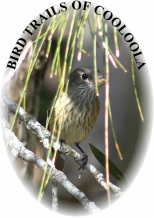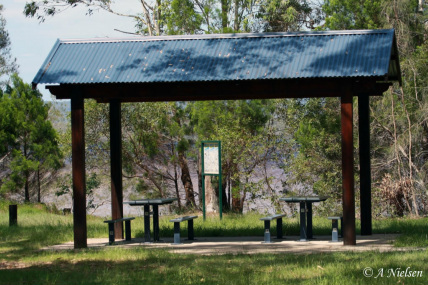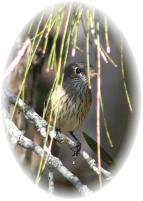Birding Cooloola Mountains To Shore
"Mullens' Creek Park & Cooloola Foreshores"
Along the "Bird Trails of Cooloola"
About “Mullens' Creek Park & Cooloola Foreshores”
Situated at the mouth of Mullens’ Creek, “Mullens’ Creek Park & Cooloola Foreshores” is a popular destination for Cooloola Cove residents
& visitors alike.
Swimming, Boating, or Kayaking in its’ quiet secluded waters, Fishing, or simply walking along its foreshore are all popular and relaxing pastimes.
It is also home to an impressive variety of Birds!
Well tended grounds, shelter sheds, barbecue facilities and toilets are placed in such a secluded setting that you can imagine yourself miles from
anywhere, though Cooloola Cove Shopping Centre is only a short drive from here, while Tin Can Bay is within ten minutes driving time.
The adjacent wetlands are also a major feeding and roosting ground for many significant wader birds, subject to two international conventions,
the China-Australia Migratory Bird Agreement (CAMBA) and the Japan-Australia Migratory Bird Agreement (JAMBA).
The wetlands of “Mullens’ Creek Park & Cooloola Foreshores”, and the Great Sandy Straits, are of international significance, listed under the
Convention of Wetlands agreement (Ramsar).
(Click on the link below for more information)
The Ramsar Convention on Wetlands 2010
Wish to visit “Cooloola Cove”? Click here for Map
Where is “Tin Can Bay”? Click here for Map
Wish to stay at Tin Can Bay?
(Click on highlighted text below)
Tin Can Bay Motel
Accommodation Tin Can Bay
Tin Can Bay Tourist Park
Ace Caravan Park
Kingfisher Caravan Park
(For Origin of Place Names Tin Can Bay, Mullens’, Cooloola, & others, Click here)
__________________________________________________________________________________________________________
Your Birding Experience –
“Mullens’ Creek Park & Cooloola Foreshores” offers the best of “Bush & Beach” for Birders.
“Bird” the Picnic Area, along Bayside Road, or along the Foreshore.
Watch for Leaden Flycatcher, Rufous Whistler & Little Shrike-thrush.
In the warmer months Scarlet, Lewin’s, and Yellow-faced Honeyeaters, among others, feed on the flowering Melaleucas.
“Bird” the Mangroves from the Foreshore edge, or if you have a Kayak, enjoy an idyllic paddle through the Mangrove-lined
channels of Mullens’ Creek estuary.
Watch for Mangrove & Azure Kingfisher, Mangrove Gerygone & Honeyeater, while during September to March, Whimbrel & Common Greenshank
are among Shorebird species to be seen roosting in the Mangroves.
“Bird” Mullens’ Shorebird Roost, (best from September to March).
(Note – this is a Tidal Wetland excursion; it is recommended that appropriate footwear & clothing for associated wet & muddy conditions are worn!)
To check Tide Times Click here
Shorebirds are special!
Only here from early September to escape the harsh Northern Winter, Shorebirds, (often called Waders), must feed intensively on our Tidal Wetlands
in order to build up fat reserves before departure to their Northern breeding grounds in late March to early April.
Please avoid disturbance of these seasonal visitors during this feeding & resting period.
A suitable Telescope & set of Binoculars are essential for viewing.
For more information on the Wonders of our Migratory Shorebirds, visit the following –
“Shorebirds and Seabirds of the Cooloola Coast”
“More about Shorebirds”
To Print Out the Brochure “Birds of Mullens’ Creek Park & Cooloola Foreshores” – Click here
(All species listed recorded from the Bayside Road turnoff to the “Mullens’ Shorebirds Roost” & through Mullens’ Creek Estuary)
Click here to view “The Ethics of Birdwatching”
Please follow “Birdwatching Ethics” as you enjoy your stay!
__________________________________________________________________________________________________________
Situated at the mouth of Mullens’ Creek, “Mullens’ Creek Park & Cooloola Foreshores” is a popular destination for Cooloola Cove residents
& visitors alike.
Swimming, Boating, or Kayaking in its’ quiet secluded waters, Fishing, or simply walking along its foreshore are all popular and relaxing pastimes.
It is also home to an impressive variety of Birds!
Well tended grounds, shelter sheds, barbecue facilities and toilets are placed in such a secluded setting that you can imagine yourself miles from
anywhere, though Cooloola Cove Shopping Centre is only a short drive from here, while Tin Can Bay is within ten minutes driving time.
The adjacent wetlands are also a major feeding and roosting ground for many significant wader birds, subject to two international conventions,
the China-Australia Migratory Bird Agreement (CAMBA) and the Japan-Australia Migratory Bird Agreement (JAMBA).
The wetlands of “Mullens’ Creek Park & Cooloola Foreshores”, and the Great Sandy Straits, are of international significance, listed under the
Convention of Wetlands agreement (Ramsar).
(Click on the link below for more information)
The Ramsar Convention on Wetlands 2010
Wish to visit “Cooloola Cove”? Click here for Map
Where is “Tin Can Bay”? Click here for Map
Wish to stay at Tin Can Bay?
(Click on highlighted text below)
Tin Can Bay Motel
Accommodation Tin Can Bay
Tin Can Bay Tourist Park
Ace Caravan Park
Kingfisher Caravan Park
(For Origin of Place Names Tin Can Bay, Mullens’, Cooloola, & others, Click here)
__________________________________________________________________________________________________________
Your Birding Experience –
“Mullens’ Creek Park & Cooloola Foreshores” offers the best of “Bush & Beach” for Birders.
“Bird” the Picnic Area, along Bayside Road, or along the Foreshore.
Watch for Leaden Flycatcher, Rufous Whistler & Little Shrike-thrush.
In the warmer months Scarlet, Lewin’s, and Yellow-faced Honeyeaters, among others, feed on the flowering Melaleucas.
“Bird” the Mangroves from the Foreshore edge, or if you have a Kayak, enjoy an idyllic paddle through the Mangrove-lined
channels of Mullens’ Creek estuary.
Watch for Mangrove & Azure Kingfisher, Mangrove Gerygone & Honeyeater, while during September to March, Whimbrel & Common Greenshank
are among Shorebird species to be seen roosting in the Mangroves.
“Bird” Mullens’ Shorebird Roost, (best from September to March).
(Note – this is a Tidal Wetland excursion; it is recommended that appropriate footwear & clothing for associated wet & muddy conditions are worn!)
To check Tide Times Click here
Shorebirds are special!
Only here from early September to escape the harsh Northern Winter, Shorebirds, (often called Waders), must feed intensively on our Tidal Wetlands
in order to build up fat reserves before departure to their Northern breeding grounds in late March to early April.
Please avoid disturbance of these seasonal visitors during this feeding & resting period.
A suitable Telescope & set of Binoculars are essential for viewing.
For more information on the Wonders of our Migratory Shorebirds, visit the following –
“Shorebirds and Seabirds of the Cooloola Coast”
“More about Shorebirds”
To Print Out the Brochure “Birds of Mullens’ Creek Park & Cooloola Foreshores” – Click here
(All species listed recorded from the Bayside Road turnoff to the “Mullens’ Shorebirds Roost” & through Mullens’ Creek Estuary)
Click here to view “The Ethics of Birdwatching”
Please follow “Birdwatching Ethics” as you enjoy your stay!
__________________________________________________________________________________________________________
Road Conditions – Access to “Mullens’ Creek Park & Cooloola Foreshores” is via the well sealed Tin Can Bay Road to -
Exit right into Bayside Road – Bayside Road is sealed –
Follow Bayside Road sharp left at “Picnic Area” sign - Bayside Road is sealed until –
Short section just before Picnic Area – This is unsealed; take care in negotiating existing potholes & corrugations
(Click here to Refer Map in “Take the Bird Trails of Cooloola!”)
(Note - Please disregard "Walking Directions" as shown in Map Inset; this should read "Driving Directions" -
Total time from "Lake Alford", (starting point for all "Bird Trails), being approximately 60 minutes)
Please drive according to conditions on all “Bird Trails of Cooloola”
For a Digital Map to “Mullens’ Creek Park & Cooloola Foreshores” – Click Here
(Note - Please disregard "Walking Directions" as shown in Map Inset; this should read "Driving Directions" -
Total time from "Lake Alford", (starting point for all "Bird Trails), being approximately 60 minutes)
Habitat Type (As per Regional Ecosystem (RE) Data) –
RE 12.2.7 - Melaleuca quinquenervia or M. viridiflora open forest to woodland on sand plains
RE 12.2.12 - Closed heath on seasonally waterlogged sand plains
RE 12.2.11 - Corymbia spp., Eucalyptus spp., Acacia spp. open forest to low closed forest on beach ridges in northern half of bioregion
RE 12.1.2 - Saltpan vegetation including grassland and herbland on marine clay plains
RE 12.3.4 - Melaleuca quinquenervia, Eucalyptus robusta open forest on or near coastal alluvial plains
_______________________________________________________________________________________________________
Foreshore & “Mullens’ Shorebird Roost” Walking Excursion -
Ease of Difficulty – Moderate
Km - (Return)
Walking Conditions – Tidal Wetlands and Mudflats; depending on Tide height, some water crossing may be expected. It may be necessary to avoid
deeper water by traversing the Foreshore edge. Expect rough ground, exposed tree roots and undergrowth in these situations.
Points to Note for your Safety – Appropriate footwear, clothing, Sunscreen & Insect Repellant are recommended for your Onshore & Foreshore
“Birding”, as is appropriate protective footwear if venturing onto the tidal flats.
Directions – On exiting the Picnic Area, walk to the left along the Foreshore. Entrance to the Shorebird Roost is designated by Shorebird signage set back
from the Foreshore edge.
What to expect of your Excursion – “Mullens’ Creek Park & Cooloola Foreshores” offers the best of Bush & Beach for Birdwatchers!
Your walk along the Foreshore will provide the perfect opportunity to “Bird” the forest edge.
Keep a watch though for Shorebirds that may be feeding on the Tidal Flats if you have chosen a low Tide for your excursion!
If you happen to be visiting from September to April, you will find flocks of these amazing Northern Hemisphere visitors resting or feeding at their
Roost Site.
Please follow “Birdwatching Ethics” in respecting their remarkable achievement by providing the least possible disturbance during their stay on our Shores.
Among the variety of Bird Species you may encounter while at “Mullens’ Creek Park & Cooloola Foreshores” are –
Little Pied Cormorant, Pied Cormorant, Little Black Cormorant, Little Egret, Eastern Great Egret, Intermediate Egret, Striated Heron, Black-necked Stork, Eastern Osprey, Brahminy Kite, White-bellied Sea-Eagle, Bar-tailed Godwit, Whimbrel, Eastern Curlew, Lesser Crested Tern, Crested Tern, Little Tern,
Red-tailed Black-Cockatoo, Red-winged Parrot, Pale-headed Rosella, Mangrove Honeyeater, White-cheeked Honeyeater, Scarlet Honeyeater,
Eastern Yellow Robin
(Note – Surveying conditions and Bird Species as described are accurate at time of compilation; these may vary over time with
the influence of climate and other factors)
Click here to view “Your Health & Safety while Birdwatching”
_______________________________________________________________________________________________
For “Some Birds of “Mullens’ Creek Park & Cooloola Foreshores” Click here
For “Habitats of “Mullens’ Creek Park & Cooloola Foreshores” Click here
To view a Video from “Mullens’ Creek Park & Cooloola Foreshores” Click here (Note – This Link is to be Established)
_______________________________________________________________________________________________
Exit right into Bayside Road – Bayside Road is sealed –
Follow Bayside Road sharp left at “Picnic Area” sign - Bayside Road is sealed until –
Short section just before Picnic Area – This is unsealed; take care in negotiating existing potholes & corrugations
(Click here to Refer Map in “Take the Bird Trails of Cooloola!”)
(Note - Please disregard "Walking Directions" as shown in Map Inset; this should read "Driving Directions" -
Total time from "Lake Alford", (starting point for all "Bird Trails), being approximately 60 minutes)
Please drive according to conditions on all “Bird Trails of Cooloola”
For a Digital Map to “Mullens’ Creek Park & Cooloola Foreshores” – Click Here
(Note - Please disregard "Walking Directions" as shown in Map Inset; this should read "Driving Directions" -
Total time from "Lake Alford", (starting point for all "Bird Trails), being approximately 60 minutes)
Habitat Type (As per Regional Ecosystem (RE) Data) –
RE 12.2.7 - Melaleuca quinquenervia or M. viridiflora open forest to woodland on sand plains
RE 12.2.12 - Closed heath on seasonally waterlogged sand plains
RE 12.2.11 - Corymbia spp., Eucalyptus spp., Acacia spp. open forest to low closed forest on beach ridges in northern half of bioregion
RE 12.1.2 - Saltpan vegetation including grassland and herbland on marine clay plains
RE 12.3.4 - Melaleuca quinquenervia, Eucalyptus robusta open forest on or near coastal alluvial plains
_______________________________________________________________________________________________________
Foreshore & “Mullens’ Shorebird Roost” Walking Excursion -
Ease of Difficulty – Moderate
Km - (Return)
Walking Conditions – Tidal Wetlands and Mudflats; depending on Tide height, some water crossing may be expected. It may be necessary to avoid
deeper water by traversing the Foreshore edge. Expect rough ground, exposed tree roots and undergrowth in these situations.
Points to Note for your Safety – Appropriate footwear, clothing, Sunscreen & Insect Repellant are recommended for your Onshore & Foreshore
“Birding”, as is appropriate protective footwear if venturing onto the tidal flats.
Directions – On exiting the Picnic Area, walk to the left along the Foreshore. Entrance to the Shorebird Roost is designated by Shorebird signage set back
from the Foreshore edge.
What to expect of your Excursion – “Mullens’ Creek Park & Cooloola Foreshores” offers the best of Bush & Beach for Birdwatchers!
Your walk along the Foreshore will provide the perfect opportunity to “Bird” the forest edge.
Keep a watch though for Shorebirds that may be feeding on the Tidal Flats if you have chosen a low Tide for your excursion!
If you happen to be visiting from September to April, you will find flocks of these amazing Northern Hemisphere visitors resting or feeding at their
Roost Site.
Please follow “Birdwatching Ethics” in respecting their remarkable achievement by providing the least possible disturbance during their stay on our Shores.
Among the variety of Bird Species you may encounter while at “Mullens’ Creek Park & Cooloola Foreshores” are –
Little Pied Cormorant, Pied Cormorant, Little Black Cormorant, Little Egret, Eastern Great Egret, Intermediate Egret, Striated Heron, Black-necked Stork, Eastern Osprey, Brahminy Kite, White-bellied Sea-Eagle, Bar-tailed Godwit, Whimbrel, Eastern Curlew, Lesser Crested Tern, Crested Tern, Little Tern,
Red-tailed Black-Cockatoo, Red-winged Parrot, Pale-headed Rosella, Mangrove Honeyeater, White-cheeked Honeyeater, Scarlet Honeyeater,
Eastern Yellow Robin
(Note – Surveying conditions and Bird Species as described are accurate at time of compilation; these may vary over time with
the influence of climate and other factors)
Click here to view “Your Health & Safety while Birdwatching”
_______________________________________________________________________________________________
For “Some Birds of “Mullens’ Creek Park & Cooloola Foreshores” Click here
For “Habitats of “Mullens’ Creek Park & Cooloola Foreshores” Click here
To view a Video from “Mullens’ Creek Park & Cooloola Foreshores” Click here (Note – This Link is to be Established)
_______________________________________________________________________________________________



